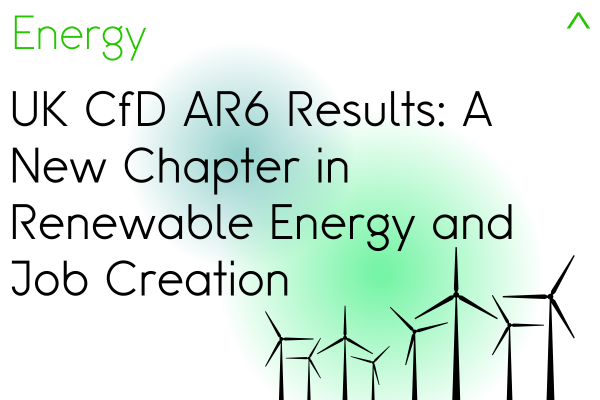
UK CfD AR6 Results: A New Chapter in Renewable Energy and Job Creation
12 Sept, 20245 minsOn September 3, 2024, the UK government unveiled the results of its latest renewable energy ...

On September 3, 2024, the UK government unveiled the results of its latest renewable energy auction, setting the stage for what many are calling a watershed moment in the country’s transition to clean power. The sixth Contracts for Difference (CfD) Allocation Round, known as AR6, has not only shattered records but also rekindled hope in the UK’s ambitious climate goals.
Background: The UK’s Contracts for Difference Scheme
The Contracts for Difference (CfD) scheme, introduced in 2014, is the UK government’s primary mechanism for supporting low-carbon electricity generation. CfDs provide developers with a stable income stream, effectively removing price volatility risk and making renewable energy projects more attractive to investors.
In a CfD auction, developers bid for contracts, with successful bidders guaranteed a fixed price (the “strike price”) for their electricity over a 15-year period. This price stability has been crucial in driving down the costs of renewable energy and accelerating the UK’s clean energy transition.
AR6 Results: A Detailed Analysis
The sixth allocation round of the CfD scheme has been hailed as the most successful to date, marking a significant turnaround from the previous year’s results. Here’s a deeper dive into the outcomes:
1. Record-Breaking Capacity
• Total awarded capacity: 9.6GW across 131 projects
• This represents nearly a tripling of capacity compared to AR5 (3.7GW)
2. Technology Breakdown
• Offshore Wind: 6GW (excluding floating offshore wind)
o Includes 1.6GW of rebid capacity from previous rounds
• Solar PV: 3.3GW
• Onshore Wind: 1GW
• Floating Offshore Wind: 400MW
• Tidal Stream: 28MW
3. Striking Prices
• Offshore Wind:
o New projects: £58.87/MWh
o Rebid projects: £54.23/MWh
• Solar PV: £50.07/MWh
• Onshore Wind: £50.90/MWh
• Floating Offshore Wind: £139.93/MWh
• Tidal Stream: £172/MWh
4. Geographic Distribution
• Offshore projects primarily in the North Sea
• Onshore wind concentrated in Scotland (18 out of 22 projects)
• Solar PV projects more evenly distributed across Great Britain
5. Notable Projects
• Hornsea 3 & 4 (Ørsted): Combined capacity of 3,480MW
• East Anglia Two & Three (ScottishPower Renewables): Total of 1,122MW
• Green Volt (Flotation Energy & Vårgrønn): 400MW floating offshore wind
• Longfield Solar Energy Farm (EDF Renewables): 299MW
Implications for the Renewable Energy Sector
The success of AR6 signals a new chapter for the UK’s renewable energy sector, with far-reaching implications:
1. Market Confidence
The strong performance across technologies, particularly the return of offshore wind, has renewed confidence in the UK’s renewable energy market. This is likely to attract further investment and could accelerate project development timelines.
2. Technology Maturity
The competitive strike prices achieved demonstrate the increasing maturity and cost-effectiveness of renewable energy sources. This trend is likely to continue, potentially leading to subsidy-free projects in future rounds.
3. Supply Chain Pressures
The significant increase in awarded capacity will place considerable pressure on the supply chain. This could lead to bottlenecks in manufacturing, particularly for components like turbines, foundations, and cables.
4. Grid Integration Challenges
The influx of new renewable capacity will necessitate substantial grid reinforcement and smart grid solutions to manage intermittency and ensure system stability.
5. Policy Alignment
The success of AR6 aligns with the UK government’s ambitious targets for renewable energy deployment, including the goal to quadruple offshore wind capacity by 2030. However, challenges remain in streamlining planning processes and grid connections to meet these targets.
The Human Element: Implications for Jobs and Skills
Behind the gigawatts and strike prices lies a compelling narrative of job creation and skills development. The success of AR6 is set to trigger a jobs boom in the renewable energy sector, potentially creating thousands of new roles across the UK. Here’s a detailed look at the hiring implications:
1. Surge in Demand for Specialised Skills
• Offshore Wind: Increased demand for roles in marine engineering, geotechnical engineering, and offshore construction management.
• Solar PV: Need for solar design engineers, installation technicians, and operations & maintenance specialists.
• Floating Offshore Wind: Emerging opportunities in floating platform design, dynamic cable systems, and mooring specialists.
2. Project Development and Finance
• Heightened demand for renewable energy project managers with CfD expertise.
• Increased need for financial analysts specialising in renewable energy project finance and risk assessment.
3. Supply Chain and Logistics
• Growth in roles related to renewable energy supply chain management.
• Increased demand for logistics specialists with experience in oversized cargo transportation.
4. Grid Integration and Smart Energy Systems
• Rising demand for power systems engineers and grid integration specialists.
• Opportunities for data analysts and AI specialists in smart grid management.
5. Environmental and Planning Roles
• Increased need for environmental impact assessment specialists.
• Growing demand for planning consultants with renewable energy expertise.
6. Research and Development
• Opportunities in R&D for next-generation renewable technologies.
• Demand for materials scientists and engineers to improve efficiency and reduce costs.
7. Skills Transfer and Reskilling
• Potential for skills transfer from oil and gas sector, particularly for offshore wind.
• Need for training programmes to reskill workers from adjacent industries.
8. Regional Job Creation
• Significant job creation expected in coastal communities, particularly in Scotland and the North East of England.
• Potential for the development of renewable energy hubs and clusters.
9. Digital Skills
• Increasing importance of digital skills across the sector, from project design to asset management.
• Growing demand for professionals with expertise in digital twin technology and IoT for renewable assets.
10. Soft Skills and Interdisciplinary Roles
• Rising importance of professionals who can bridge technical and commercial aspects of renewable projects.
• Increased demand for roles in stakeholder engagement and community relations.
Challenges and Opportunities
The sheer scale of growth predicted by AR6 raises questions about the UK’s readiness to meet this demand for skilled workers. There’s a risk that without proper planning, skills shortages could bottleneck the very projects meant to drive the UK’s green revolution.
This challenge, however, presents an opportunity in itself. It calls for a concerted effort from government, industry, and educational institutions to create robust training programmes and clear career pathways into the renewable energy sector. It’s a chance to retool and reskill workers from other industries, offering new hope to communities that may have been left behind by previous industrial transitions.
Conclusion
As the UK stands on the brink of this green energy boom, the success of AR6 feels like more than just an auction result—it’s a glimpse into a future where clean power and economic growth go hand in hand. For job seekers and hiring managers, the message is clear: the renewable energy sector is not just about saving the planet; it’s about building a new economy, one that promises challenging, rewarding careers for decades to come.
The road ahead won’t be without its bumps. Supply chain issues, planning hurdles, and the sheer scale of the transition will present ongoing challenges. But if AR6 has shown us anything, it’s that with the right mix of innovation, policy support, and human ingenuity, the UK’s green energy revolution is not just possible—it’s already underway.
As we look to the future, one thing is certain: the success of AR6 isn’t just about megawatts and strike prices. It’s about people—the engineers, technicians, managers, and innovators who will build the clean energy systems of tomorrow. For those ready to seize the opportunity, opportunity starts now.

